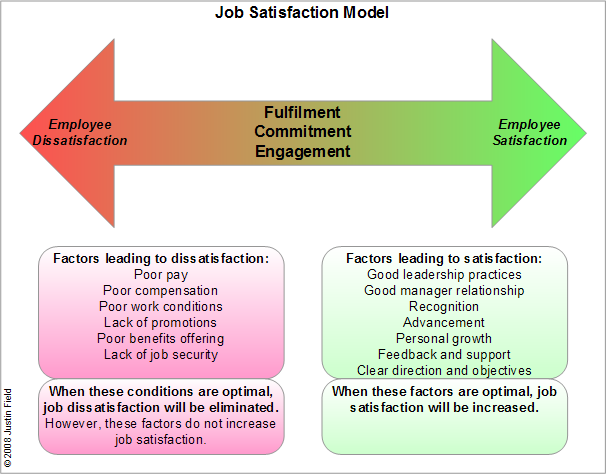Job Satisfaction Model for retention
Posted by Justin Field on April 11, 2008
I’ve been studying turnover and retention recently and it led me to wonder about the real reasons for turnover. Everybody understands that some turnover is functional (or beneficial to the organisation) and some turnover is dysfunctional (bad for the organisation). And we all understand that some turnover is necessary, otherwise organisations would stagnate.
So, the fundamental reason that employees leave organisations is that they are not satisfied. Their dissatisfaction could occur on many levels. Much published research on turnover indicates that money is often NOT the most important reason. Employees leave for other reasons such as career growth and development, or a change in life circumstances, or factors like that.
It’s handy to think of the reasons for dissatisfaction in terms of push factors (things that make employees more dissatisfied) and pull factors (things that make employees more satisfied). Here’s a diagram.
The factors that are going to make some MORE dissatisfied are things like:
- poor pay
- poor compensation
- poor work conditions
- lack of promotions
- poor benefits offering
- lack of job security
Curiously enough, if you were to fix all these factors, you’d still not get a satisfied employee. If you fixed everything above, you’d have an employee sitting somewhere in the middle of the satisfaction scale, so they would be neither satisfied nor dissatisfied.
The factors that make an employee MORE satisfied are things like:
- good leadership in the organisation
- good relationship with their manager
- recognition for their achievements (not necessarily monetary recognition)
- advancement in their careers
- personal growth and development
- feedback and support (meaningful feedback, not just naked criticism)
- clear direction and objectives
So there is a lot that can be done on the positive side to increase satisfaction. Naturally, there are of course many opportunities on this side of the house where a good talent management solution can helps things along.




How to calculate risk of loss « TalentedApps said
[…] month I wrote about the job satisfaction model for employee retention. Now I have used the model to develop a model that allows you to calculate the probability of […]
The Corporate Death of the Synergistic Team? « TalentedApps said
[…] so companies are consumed by the hot topics of employee engagement and retention; they strive to tie employee goals and performance to corporate goals; they pre-screen to ensure […]
Amy Wilson said
Justin – 7 months later, this is still a great post! I find the “pull” aspect really fascinating. When is a pull factor strong enough to counteract a push factor? For example, is good feedback enough to create satisfaction in the absence of poor compensation and lack of job security?
Job Satisfaction Guaranteed « TalentedApps said
[…] by Amy Wilson on December 3, 2008 Our most popular post is Justin’s fabulous job satisfaction model, where he outlines the push and pull factors that result in higher or lower satisfaction. The […]
sandrar said
Hi! I was surfing and found your blog post… nice! I love your blog. 🙂 Cheers! Sandra. R.
sasam said
To the author: Hi. I’d like to include your model into my assay, so I’m asking for you permission. My email is sasam1400@yahoo.com. Regards.
Meg Bear said
Sasam, I’ve dropped Justin a line to connect with you directly.
cheers,
-Meg
hany said
was this article published at any scientific magazine
please give me the date and volume or any thing to refer to it in my research
Meg Bear said
This is a very popular and unique blog post that is the work of Justin Field, our own TalentedApps Blogger. Please contact Justin directly (justin.field@oracle.com) for information on how to refer to this work in your research.
-Meg
0745932170 said
this model looks exactly the same like those from school, but now, when unemployment is very high, i’m wondering if the simple job isn’t the most safe even without satisfaction
sweets said
hi, m doing a research on job satisfaction and i like to include your model in my essay and wants to thanks to you